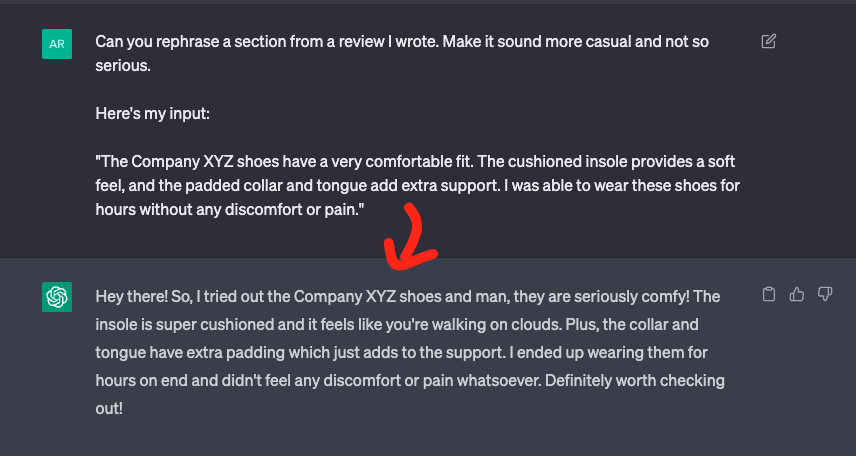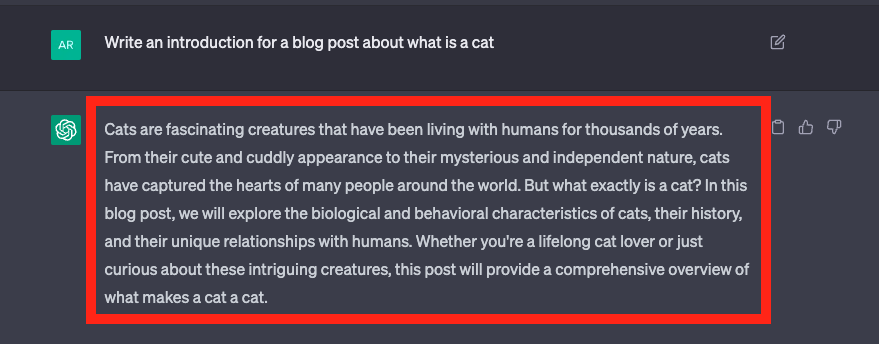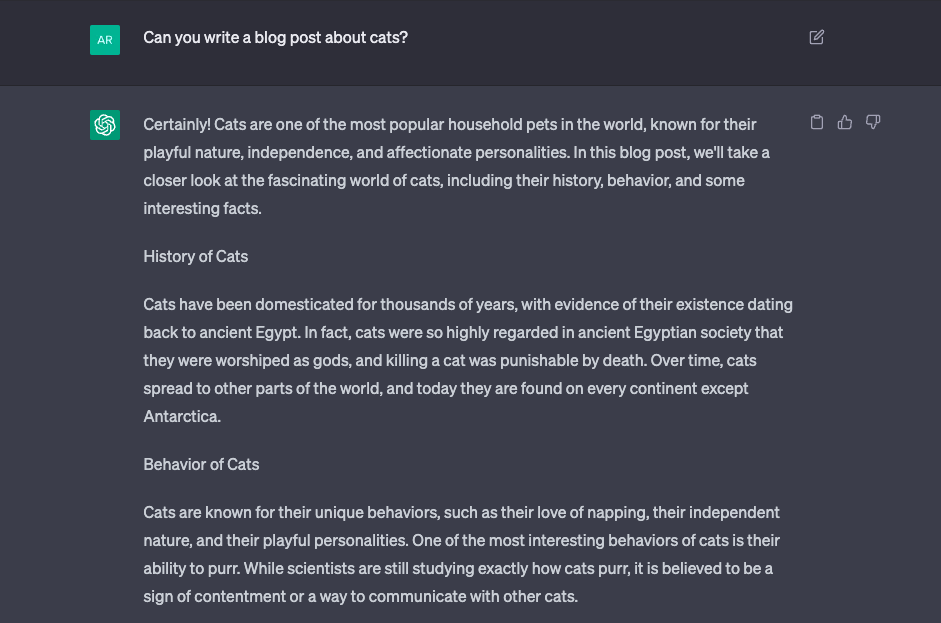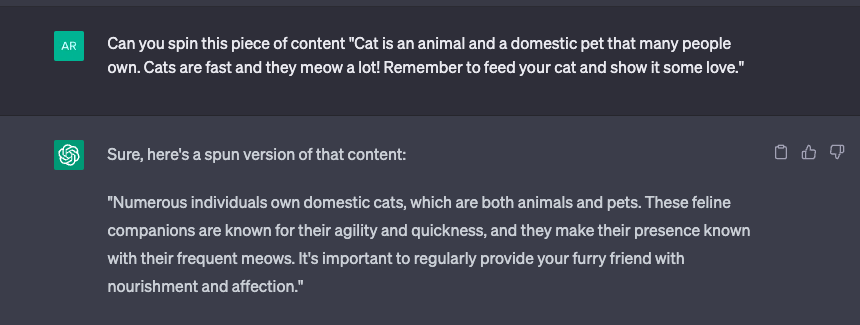Don’t use ChatGPT to automate blog posts. Instead, use it to your assistance when you get stuck.
I’ve tried to automate blog posts with AI. That has never worked!
If it worked, everyone would do it, and that would leave no room to stand out… So don’t do it!
This is a guide where I teach you how to use ChatGPT to your advantage. But this is not an automation guide. It will save you 2-3% of your time in the best case. 🙂
3 Ways to Write Blogs with AI
#1 Refine Your Writing with ChatGPT
ChatGPT can be a useful resource when it comes to refining and clarifying your writing.
You might have an idea what to write about but the message ends up looking unclear. This still happens to me all the time and is common for beginners.
This is where ChatGPT can help.

It helps you to rephrase and simplify your message, making it more digestible for your readers.
Let’s take a look at an example of how ChatGPT can simplify a sentence:
Before ChatGPT: “The multifaceted and intricate nature of the synergistic interplay between numerous factors in the convoluted sphere of human behavior demands an exhaustive and comprehensive understanding of the underlying complexities.“
After ChatGPT: “Understanding human behavior requires examining the many factors that interact with each other in complex ways.“
The revised sentence is significantly clearer and more concise.
By using ChatGPT to rephrase your writing, you can ensure that your message is easily understood by your audience, without sacrificing its core meaning. Just make sure that the facts remain and that the rephrased text is actually easier to understand.
Avoid jargon and losing information!
#2 Write Formality Content (e.g. Intros)
While ChatGPT can help refine your writing, it also helps generate introductions and conclusions and provides some information in your blog posts.

But remember to take these with a grain of salt. The ChatGPT outputs are usually full of jargon and misleading information.
Make sure to review and edit any AI-generated content to ensure that it is accurate, aligns with your perspective, and does not spread misinformation.
I’ve seen that the more you trust ChatGPT (or any other AI) the worse the content quality gets.
#3 Turn Your Expertise into Blog Posts
Use AI to turn your notes into blog post sections! This is one of the best use cases I’ve found thus far.
However, it’s crucial to recognize that ChatGPT is not a replacement for human experience.
This sounds like a useless “don’t try this at home” warning. But it’s for real. If you automate stuff with ChatGPT, you won’t see any significant results.
Test products, research, experiment, work, or do whatever it takes to become an expert in your niche. ChatGPT cannot perform these tasks or think like a human.

It can only assist you in generating text based on the information you provide.
To effectively use ChatGPT in this capacity, begin by organizing your thoughts and key points clearly and concisely.
A bulleted list or a brief outline can be an excellent starting point.
This will serve as a foundation for ChatGPT to expand upon, turning your main points into a more comprehensive and engaging blog post section.
For example, let’s say you’ve tested a pair of running shoes. To write a blog post that reviews the shoes, you can tell ChatGPT the following details:
- Comfort level
- Traction on various surfaces
- Breathability
- Overall design and aesthetics
- Price and value for money
From these ChatGPT can turn your messages into full-blown text chapters.

Just remember to do edits, because ChatGPT cannot read your thoughts. It can give you some direction, but if you automate it, the content will just become unclear and full of jargon.
3 Ways NOT to Use ChatGPT in Blogging
#1 Creating Value and Originality
ChatGPT takes input and predicts an output based on the patterns it has learned from the data it was trained on.
It doesn’t possess the ability to think or process information like a human.
Its capabilities are basically restricted to rewriting text it has seen on the internet.
Relying on ChatGPT to write a blog post from start to finish is not a viable strategy.

#2 Creating Images
Another limitation of ChatGPT is its inability to create images that truly support your blog post content.
While AI can indeed generate visually appealing stock images, it cannot conduct a study and present the results in a well-designed graph.
For example, look at this image I generated with an AI image generator:

This image looks cool, but it doesn’t help deliver the message of this post (other than offering a break for the eyes).
These tasks require human input, research, and effort. Also, these are what make blog posts truly valuable and insightful reads.
Providing relevant visuals, like screenshots, custom illustrations, or informative graphs, can enhance the user experience and improve the quality of your blog post.
Invest time and effort into research, writing, and creating or sourcing relevant visuals that complement your text. Otherwise, that #1 spot on Google is far beyond your reach!
#3 Content Spinning
Spinning content involves taking an existing piece of writing and rephrasing it to create a seemingly “new” article.

Not only is it unethical to do this, but it doesn’t make sense. At least it won’t give you success in search engines.
ChatGPT can help you rephrase and rewrite the text. But using it to spin other people’s content simply results in replicating the original post without adding to the internet. This always prevents your content from ranking on search results.
Search engines like Google prioritize content that is fresh, informative, and engaging.
Their algorithms identify (and punish) spun content. Relying on such practices can not only limit your blog’s visibility but also damage your reputation.
Instead of spinning content, focus on using ChatGPT as a tool to improve your ideas and research.
Wrapping Up
Don’t use ChatGPT to write blog posts. Just use it as an assistant. Fully or semi-automated AI posts will never rank on Google. You need to spend hours per post to make it work!
